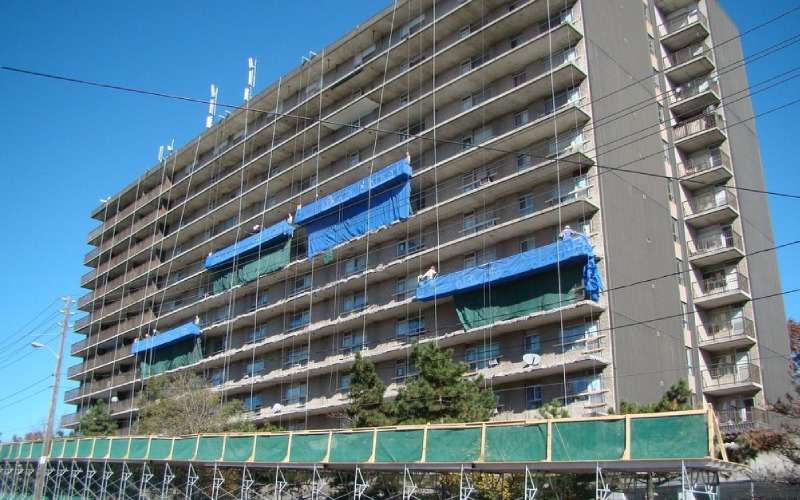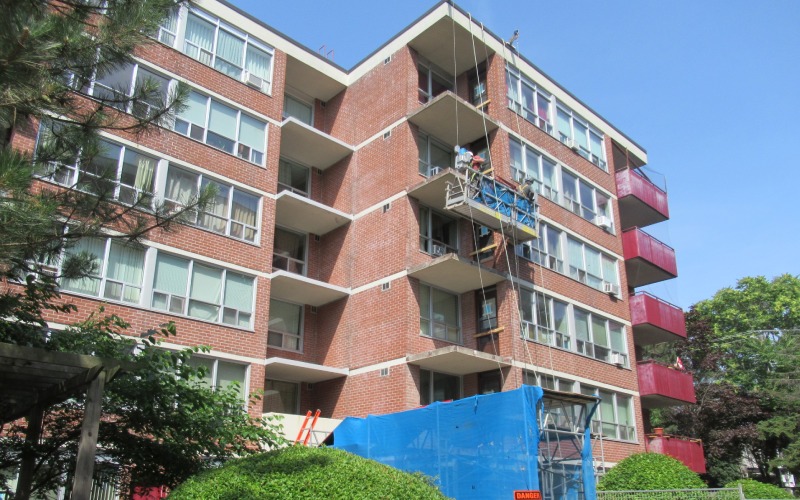500 Hood Road, Suite 320Markham ONL3R 9Z3

Restoring balconies revitalizes commercial buildings, improving their safety, functionality, and aesthetic appeal. Properly maintained balconies contribute significantly to property value and tenant satisfaction, so it is important for commercial building owners and property managers not to neglect this aspect of building maintenance.
The first step in any restoration project is a thorough assessment. This involves inspecting the balconies for structural damage, water infiltration, and wear and tear. There are several key areas to examine.
Look for signs of cracking, spalling, and rusting in the concrete and steel reinforcements. These issues can compromise the balcony's safety.
Check for water stains, efflorescence (white, powdery residue), and mold. Water infiltration can weaken structural components and lead to costly repairs if not addressed promptly.
Evaluate the condition of the balcony surfaces, including flooring, railings, and any coatings. Look for peeling paint, loose tiles, or deteriorated waterproof membranes.
After identifying the issues, develop a detailed restoration plan. This plan should outline the scope of work, budget, timeline, and materials required. Consulting with a structural engineer ensures all potential problems are identified and addressed.
Safety is paramount during balcony restoration. Implementing proper safety measures protects both the workers and the building occupants. Key safety practices include scaffolding and fall protection, debris management, and control of building access.
Compliance with local building codes and occupational health and safety regulations is essential to avoid legal issues and ensure a safe working environment.
To ensure safe restorations, employ a trusted engineering firm to oversee the project and skilled contractors to carry out the work.
Balcony restoration can be a significant investment. More extensive damage requires more materials and labour, increasing costs. However, while high-quality materials may cost more initially, they can save you money long-term by reducing maintenance and replacement frequency. Skilled labour is also essential for a durable restoration.
Use eco-friendly materials and practices wherever possible, recycling old materials like concrete and steel, and choosing materials with a low environmental footprint, such as recycled composites or low-VOC coatings.

Addressing structural issues is the most critical aspect of balcony restoration.
Damaged concrete and rusted reinforcements need to be removed and replaced with new concrete and steel. Corrosion inhibitors and bonding agents can enhance the durability of repairs.
Waterproof membranes are used to prevent water infiltration. This involves cleaning the surface and applying a primer before the liquid membrane is installed.
If railings are damaged or do not meet current safety standards, they need to be replaced with code-compliant, corrosion-resistant materials.
Once structural repairs are completed, the balcony surfaces can be restored.
Protective coatings and sealants can protect against UV rays, moisture, and wear, extending the lifespan of the balcony.
Railings, walls, and other components can be painted; high-quality, weather-resistant paints suitable for outdoor use should be used.
After restoration, ongoing maintenance is still necessary to prolong the life of the balconies. A maintenance schedule should be implemented that includes all key tasks.
Regularly inspect balconies for signs of damage or wear. Early detection of issues means they can be addressed to prevent costly repairs.
Keep balconies clean by removing debris, dirt, and mold, which can damage the balcony materials and add stresses to them. Use appropriate cleaning agents and techniques to avoid damaging surfaces.
Promptly address minor issues such as cracks, loose tiles, or peeling paint to prevent them from worsening into more expensive issues.

Ensure all restoration work complies with local building codes and regulations. Obtain necessary permits before starting the project and schedule inspections as required. Keep detailed records of the entire restoration process.
Document the initial condition of the balconies and the identified issues.
Keep records of the restoration plan, including materials used and methods applied.
Maintain logs of all maintenance activities and inspections performed after the balcony restoration.
After completing the restoration, conduct a final inspection to ensure all work meets the required standards and specifications. Involve building inspectors if necessary to obtain formal approval. This step ensures the restored balconies are safe, compliant, and ready for use.
Selecting an experienced and reputable engineering company is crucial for a successful balcony restoration project. Look for a firm with a proven track record in structural repairs, waterproofing, and surface restoration. Ensure they provide detailed assessment reports and comprehensive restoration plans, documenting the balcony's condition, scope of work, and methodologies. An engineering company that oversees the entire process, from initial assessment to final inspection, ensuring compliance with safety regulations and building codes is critical.
ABSI is a premier choice for commercial building envelope and balcony consulting, offering comprehensive assessment, planning, and oversight for damage remediation. We specialize in Building and Building Envelope Condition Assessments, including balconies. Our thorough assessments involve visual examinations, non-destructive techniques and sampling to ensure comprehensive information to guide strategies. Our top priorities are to provide safe, dependable, long-lasting solutions, offering superior value to our clients.

Naji Hassan, a renowned professional in Building Science and Engineering, brings a wealth of knowledge and experience to his field. Educated at Beirut Arab University and Harvard Business School Online, Hassan has honed his expertise in structural and municipal engineering, building science, and business management. As the President of Accent Building Sciences and an experienced Senior Project Manager, he has made significant strides in building envelope engineering, building condition assessments, and energy retrofit programs. His commitment to innovation and excellence is evident in his approach to large-scale project management and his active participation in industry organizations. Hassan is not only a leader in his field but also a prolific writer and thought leader. He regularly shares his insights and experiences through articles on LinkedIn, which can be found at LinkedIn Articles. Additionally, he maintains a blog where he delves deeper into various aspects of building science, accessible at Accent Building Sciences Blog. Outside of his professional pursuits, Hassan enjoys travel, golf, languages, gardening, and music, reflecting his diverse interests and well-rounded character. Naji Hassan's journey in building science and engineering is not just a career but a testament to his lifelong dedication to learning, teaching, and inspiring others in his field.

500 Hood Road, Suite 320Markham ONL3R 9Z3